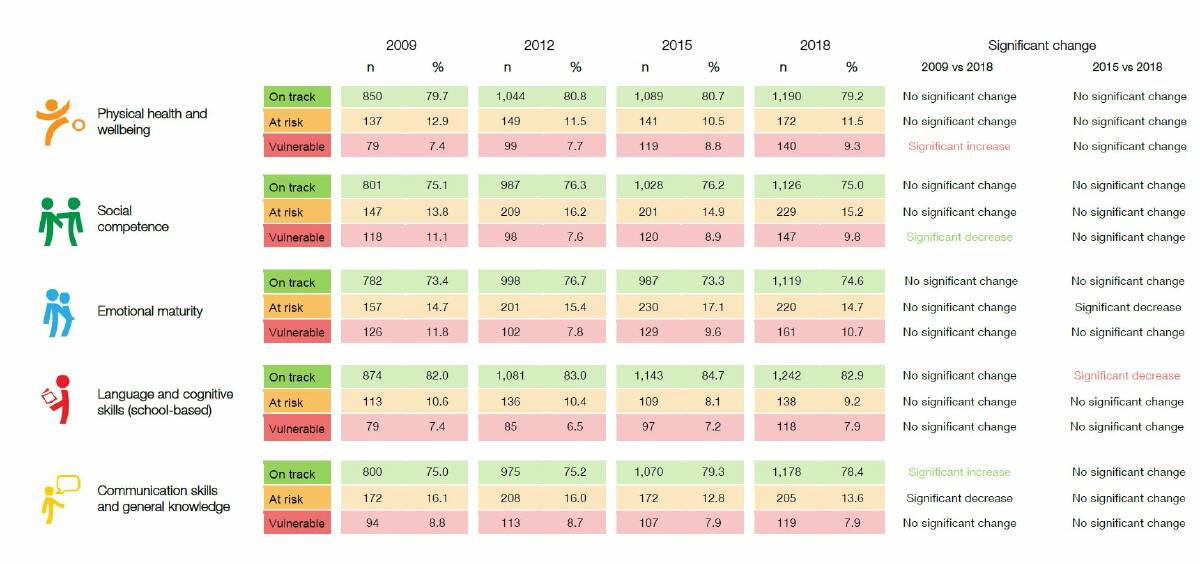
NEW Australian Early Development Census data shows more children in Greater Bendigo are starting primary school with significant problems in their development.
Subscribe now for unlimited access.
or signup to continue reading
The AEDC results show the number of Bendigo children who are vulnerable in terms of physical health and well being rose from 7.4 per cent in 2009 to 9.3 per cent in 2018. That's compared to the state average of 8.2 per cent.
"It's always disappointing to see results like that," Bendigo Communities for Children project manager Melissa Rockes said. "But we know through working in the community that there are a lot of vulnerable children so it's not a huge surprise."
The federal government survey began in 2009 and is released every three years. It measures the development of Australian children in their first year of full-time school. More than 1600 children were measured in the Greater Bendigo region.
Teachers addressed approximately 100 questions across five key domains - physical health and well being, social competence, emotional maturity, language and cognitive skills, and communication skills and general knowledge.
Each child received a score out of 10 for each domain, where zero signified the student was developmentally vulnerable. Physical health and well being referred to the child's physical readiness for the school day, physical independence and gross and fine motor schools.
Director of Children Youth and Family Support Services at Bendigo Community Health Service, Andie West, said the reasons why children were falling behind in Greater Bendigo were complex.
"It's important to look at the issue with a trauma-informed lens and with a comprehensive understanding of how inter-generational trauma can impact parents, children and families," she said.
Ms West said to break that cycle of poverty and trauma in disadvantaged communities there needed to be a focus on equity rather than equality in the social services sector.
"I think anybody who has a personal or professional role with children in the early years can have a positive impact with the children they are working with or support in some way," she said.
"From my perspective, rather than providing services equally in the community, there needs to be more of a focus on an equity-based approach.
"That's when families who need the services the most can access them rather than families who don't need the services."

The AEDC data showed those high rates of vulnerable children for physical health and well being extended across the region.
In Mount Alexander Shire, there was a significant increase recorded between the first survey in 2009 and 2018 - a jump from 8.4 per cent to 16.3 per cent.
Those high figures were reflected in Maryborough, where 17.6 per cent of children going into their first year of primary school were considered vulnerable in 2018 compared to the state average of 8.2 per cent.
In Bendigo, there were sky rocketing figures in the suburb of California Gully where 30.4 per cent of children were classified as developmentally vulnerable for physical health and well being.
That figure was more than three times the state average.
"Bendigo Community Health Services have made sure we have sites in areas where there are higher rates of families who are disadvantaged or vulnerable," Ms West said.
"This increases accessibility in those area and we will continue to increase that accessibility."
Ms Rockes said Bendigo Communities for Children were already focusing on areas like California Gully, Eaglehawk and Heathcote where numbers of vulnerable children were significantly higher than the Greater Bendigo, Victorian and Australian average.
"We already have programs there that are very focused on helping those children and families," she said. "For example, we have Mother Goose in Eaglehawk and Long Gully which provides fun activities for children.
"So we just need to be careful because the data we have received for 2018 is not necessarily reflective of the programs of the last 18 months. We will be able to determine that in the next lot of data."
The AEDC data also showed there was a significant decrease in the number of Greater Bendigo children who were on track in terms of language and cognitive skills - falling from 84.7 per cent in 2015 to 82.9 per cent in 2018.
There was also a significant decrease in the number of children in Mount Alexander Shire who were on track in their reading and writing, falling from 81.6 per cent in 2012 to only 73.2 per cent in 2018.
Education City Bendigo volunteer Maria Simpson is one of the many people who are working with preschool children to foster a love of language and reading,
"We focus on how you can build a platform for education and so every child who starts school has the language and literacy skills they require," she said.
"All of the research shows if a child finishes preschool with good literacy skills, they are more likely to go beyond year 10 and retain a job. They are also less likely to be incarcerated which proves to be a huge social cost benefit."
Ms Rockes said there needs to be a focus on collaboration within the support sector so these children who are disadvantaged receive the help they need.
"Families are complex so we need to make sure that we have wrap-around services for those who need support," she said.
Have you signed up to the Bendigo Advertiser's daily newsletter and breaking news emails? You can register below and make sure you are up to date with everything that's happening in central Victoria.


